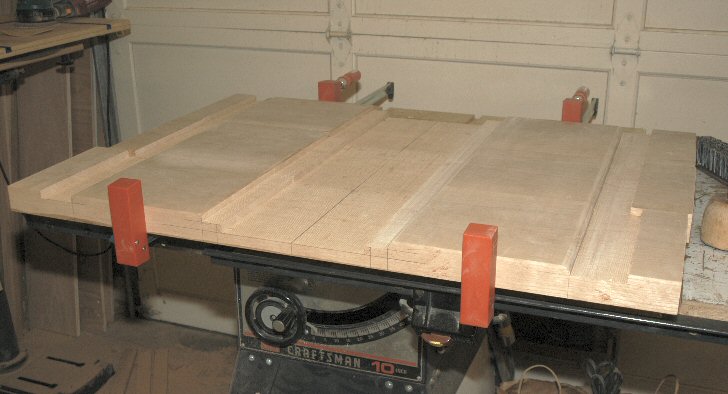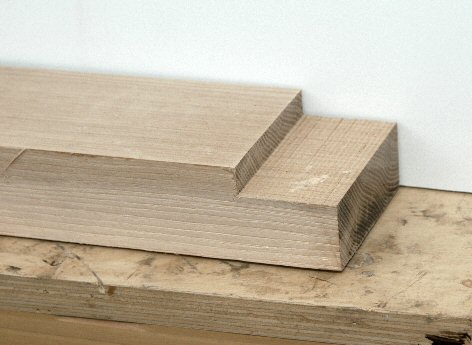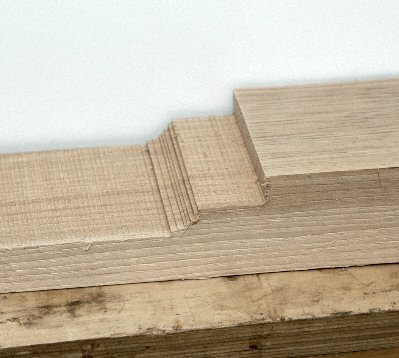
Townsend Style Chest
P. Michael Henderson
2/21/05 - John McAlister of the SAPFM contacted me yesterday evening with some information that the blockfront should be closer to 7/8 than to 1/2. Then Randy Wilkerson posted on the SAPFM forum to say that it should be 3/4 inch. This was followed by a posting by Craig Bentzley who had a cast of a Townsend shell that was about 3/4 inch. This just reinforced my opinion that the blockfront, at 1/2 inch, was just too "flat" - it didn't really stand out like the blockfronts on the chests I've seen in pictures.
For all those reasons, I decided to re-cut the blockfront for a 3/4 inch blockfront. However, a 3/4 inch blockfront means that the "innie" portion of the blockfront goes in 1 1/2 inches and the 8/4 stock I used is only 1 3/4 inches finished. To allow me to make a 3/4 inch blockfront, I purchased some 4/4 stock and glued it behind the innie portion of the blockfront to provide strength. Then I re-cut the blockfronts for a 3/4 inch protrusion. I still have to carve the curves and will include a picture when I complete that work.
2/20/05 - I finished "roughing out" the blockfront drawer fronts today. They need to be trimmed to size, both in width and length, but I won't do that until I have the case assembled and can see exactly what size to trim them to. Next, I will use the drawer fronts as templates to mark the drawer dividers. I will use the profile of the drawer front and add 3/16 inch for the cockbeading.

I wonder how our 18th Century ancestors cut out the center blockfront. Did they just chisel it out? It'd be a lot of work doing that by hand.
2/19/05 - I cut the drawer blockfronts today. It's really a nerve racking process because the three lower drawers all come from the same board. If I were to make a mistake, I probably couldn't just replace the one board - I'd have to replace all of them!
Anyway, I cut each of the drawer fronts separately and then clamped them together to trim them and to cut the corners. Here's some pictures of the work.



Cutting the inside curve was not as difficult as I expected it to be. I used some gouges which had the proper curve and then sanded with a 1/2 inch dowel.
2/18/05 - A response to my posting on the SAPFM site to ask advice on the blockfront indicated that 1/2 inch was probably correct and I decided to go with that. I purchased 8/4 stock for the drawer fronts yesterday. Today, I worked on a practice piece. I had an offcut of 8/4 pecan, and while pecan is a lot harder than cherry, I didn't have any scrap 8/4 cherry. I cut the blockfront as suggested by Alan Turner, on my table saw, using a sled. I recently bought a nice Freud 8 inch dado set but haven't built a dado sled yet so I hogged out the wood by going back and forth with my regular 10 inch blade.
Anyway, here's how it came out.

Next, I have a series of pictures which show the steps in the process.

The end is cut just like you would cut a tenon. I went a bit less than 1/2 inch down so that I could trim to the line.

On the inside, I cut 1/2 inch besides the outtie and one inch down on the innie. I stairstepped the inside curve so that it would be easier to carve out.

Here's the other side of the inside, showing the first steps in carving the curves.

And here's the other end, carved and sanded. The curve probably isn't accurate since I didn't scribe the curve and cut to the scribe mark - I just cut it freehand since it was a practice piece.
One problem I encountered is that the pecan piece cupped after I made the inside wasting cuts. I'm sure this is due to stresses in the wood so I may have to use a slightly different process for the final pieces. What I'll do is make the inside wasting cuts, then go back to the jointer and joint the back and front sides again before I make the wasting cuts on the ends. It might even be good to let the stock sit for a few days before doing the second jointer cuts. I'll see how it goes.
2/14/05 - One problem I've had with designing this chest is getting measurements of original Townsend chests. It seems that the people who own these chest no longer want to allow measurements to be made, perhaps because they don't want exact reproductions appearing on the market. After I posted my comment about needing 12/4 material for the drawers, one person contacted me and told me that the blockfront only protrudes about 1/2 half inch, rather than the close to one inch as shown in Gottshall. I'm going to continue to research that, but if that's true, I can use 8/4 material for the drawer fronts instead of 12/4. 8/4 is much less expensive per board foot and more available. Even if I choose to make the blockfront a bit more than 1/2 inch, I can glue additional material on the back of the drawer material, as long as I don't cut into the drawer more than about 1 3/4 inches (the dressed size of 8/4 material). I'll update you as I learn more
2/13/05 - I completed fabrication of the frame and panel back. The back has not been glued yet (nothings been glued yet, except the boards for the side and bottom). Note the curly Cherry - I found this in the "shorts" stack at the hardwood lumber yard - some of it has a lot of sapwood so it'll never patina like the heartwood but it really looked good for the price.

I'm kind of in a holding pattern right now. Austin (the hardwood store) was out of 12/4 cherry but keeps telling me that it'll be in "next week". One of the good things about living in a large metropolitan area is that there are a number of hardware lumber yards so I know that I can find it somewhere else if Austin doesn't get it in soon. I get wholesale prices at Austin so I'm going to give them every chance before going elsewhere.
Alan Turner gave me some very good suggestions for how to cut the blockfronts. He suggested that I go ahead and make the drawer dividers even before I cut the blockfronts but it seems to me that it would be best to cut the blockfronts and then use them as a template for cutting the dividers, since the dividers have to match the blockfront exactly. I'll probably take Alan's advice but not glue the dividers in so that if the blockfronts and dividers don't match exactly, I can re-make the dividers.
The story of the chest continues here.